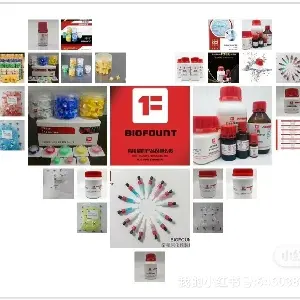2-NBDG,葡萄糖摄取荧光探针
2-NBDG(2-NBD-Glucose,86689-07-6)是荧光标记的脱氧葡萄糖类似物,用于直接监测活细胞和组织对葡萄糖的摄取。 2-NBD-Glucose用作检测瘤形成的局部造影剂。 摄取可以通过实时共聚焦、高分辨率或宽视场荧光显微镜和流式细胞术进行监测。
溶解度Solubility溶于乙醇至 50 mM,溶于 DMSO 至 25 mM性状solid,固体粉末储藏条件 Storage conditionsstorage at -4℃ (1-2weeks), longer storage period at -20℃ (1-2years)
1、2-NBDG储存液制备方法?
向 1mg粉末中加 100μl 无水DMSO 或者 乙醇,进行充分溶解混匀,制备成10mg/ml的储存液,按照单次用量进行分装后,在-20ºC避光条件下冷藏存储。若已经配制成水溶液后,建议存周期不超过一天。
如实验需要延长保存周期,最好是以粉末的形式在-20ºC条件下保存。先用乙醇溶解固体粉末,然后分装成小量装入独立瓶内,使用真空泵将溶剂抽干即可。此时不推荐用DMSO或DMF为溶剂,因挥发性比较差。
2、2-NBDG工作浓度?
2-NBDG 的常用工作浓度大约10-600μM。细菌或者酵母菌染色的建议浓度范为100-600μM,原代和传代培养哺乳动物细胞建议工作浓度范围为10-200μM。
日常实验过程 2-NBDG 工作浓度范围为: 30-300μM。
细胞需要在在合适的温度条件下孵育,以充分检测绿-黄色荧光。摄取能力强弱受温度影响,孵育时间有几秒钟,到30min,甚至更长,取决于探针终浓度、细胞类型、培养条件和一些其他因素。
案例:

编辑搜图
Delivery-corrected 2-NBDG uptake inversely correlates with blood glucose concentration. (A) Representative images show the kinetics of 2-NBDG uptake in vivo in non-tumor window chambers. The same mouse was given 6 mM or 10 mM 2-NBDG on subsequent days and imaged for 60 minutes following injection. (B) Averaged 2-NBDG kinetics for a cohort of mice injected with 0.1 mL of either 6 mM or 10 mM 2-NBDG. At 5 minutes post-injection (2-NBDG05), the fluorescence ratio of the dose groups (2-NBDG05,10 mM/2-NBDG05,6 mM) was proportional to molarity (p<0.01). The table shows the expected ratio of 10 mM/6 mM fluorescence, if all differences in fluorescence were due to dose. 2-NBDG05,10 mM/2-NBDG05,6 mM corresponds to the ratio of 10 mM and 6 mM fluorescence intensities at t = 5 min. The ratio RD,10 mM/RD,6 mM corresponds to the rate of 2-NBDG delivery for 10 mM and 6 mM. Each group in panel B contains the same n = 7 subjects. p values are from a student's paired t-test. Error bars show standard error. Values in table are mean ± standard error. (C) RD was strongly correlated with 2-NBDG fluorescence at 5 minutes (p<0.001). RD did not correlate with 2-NBDG60 (not shown). (D) 2-NBDG60/RD was inversely correlated with baseline blood glucose in normal mice (R = −0.61, p = 0.02). 2-NBDG60 was also correlated with blood glucose (R = −0.52, p = 0.05, not shown). For animals that received both 6 mM and 10 mM doses, the average values of the endpoints (2-NBDG05, 2-NBDG60, and 2-NBDG60/RD) for both doses were used in calculating the correlations. These subjects are denoted by “mean” in the legend. n = 15 mice for (C) and (D).

